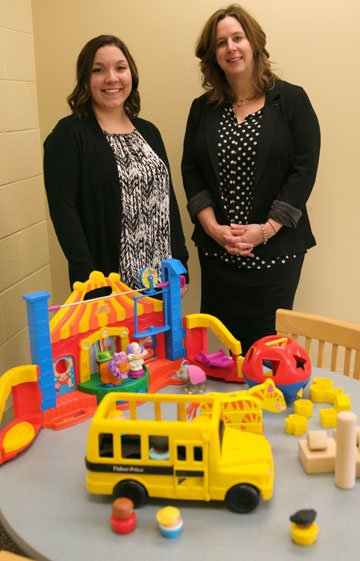Any parent knows how toys seem to magically multiply and take over a house. Do children need so many toys?
A team of University of Toledo researchers studied whether the number of toys in a toddler’s environment influenced their quality of play. Their findings: Less is definitely more when it comes to creative, healthy play.

Research by Dr. Carly Dauch, left, and Dr. Alexia Metz found less is definitely more when it comes to toys and toddlers’ creative, healthy play.
When toddlers had exposure to fewer toys, they played twice as long with the toys they had and in more sophisticated ways, said Dr. Alexia Metz, the study’s lead investigator and a UT associate professor of occupational therapy.
As the mother of 12-year-old twins, Metz has personal experience with the proliferation of toys phenomenon.
“I was astonished by how much our home filled up with stuff,” she said. “I wondered whether there was any risk to having that much stuff.”
Metz said she also had observed people worrying whether their toddlers had attention deficit disorder. Toddlers, by nature, are distractible, but she wondered whether their environment might be a factor in how they played or how easily distracted they were.
Metz and her team of graduate students studied 36 toddlers from 18 to 30 months of age. The children visited the playroom lab twice. On one visit, the children played in a room with just four toys; on the other, they had access to 16 toys.
The team charted how many times the toddler picked up a toy; how long they played with it; and how many ways they played with it.
“When there were fewer toys, they played with them in more ways,” Metz said.
In the 16-toy environment, many of the children played with 10 or more toys in the 15 minutes soon after they entered the room. By flitting from toy to toy, they didn’t take the time to explore the ways they could use each toy, Metz said.
Fewer toys led to “higher quality play,” meaning the toddler stuck with the toy for longer and played with it in more creative ways. Instead of stacking or tipping a toy, they began to hammer with it or feed it or hide it. This increased exploration may support development of motor and cognitive skills.
“Today there is the demand to have the latest and greatest toy that encourages a more technological mind. In this study, we used older toys that encouraged more creative play and tested the theory of is less really more?” said Dr. Carly Dauch, who graduated from UT in May following the completion of the study and is now an occupational therapist at the Wood County Board of Developmental Disabilities. “How the children played supported our hypothesis and provides support for deeper and richer play with fewer toys.”
Michelle Imwalle and Brooke Ocasio, who also graduated in May, were the other graduate students involved in the project.
The bottom line for parents: “If your child receives an abundance of toys, you don’t need to introduce them all at once,” Metz said. “Save some for later and swap them out. If they have a chance to explore a few toys at a time, they might have a richer experience.”
This is also good news for families who may feel guilty for not being able to shower their children with dozens of toys.
“They’re not depriving their children of an opportunity for meaningful play,” Metz said. “This is a less is more story.”